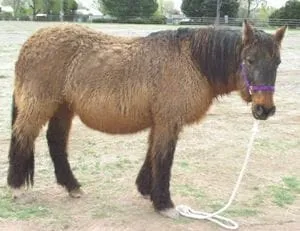
Equine Cushing’s disease, technically known as pituitary pars intermedia dysfunction (PPID), is a degenerative hormonal disease of middle-aged and senior horses. To completely understand the disease, a little background in anatomy and hormonal cycles is helpful. First, the equine pituitary is located near the base of the brain, and is composed of 3 lobes or sections. The “pars intermedia” is one of those sections. The pituitary produces a variety of hormones that regulate a wide range of body functions, including milk production, control of growth rate, body temperature, and heart rate, and reacting to stress. The pars intermedia is the portion of the pituitary in charge of producing Adrenocorticotropic Hormone (ACTH), which stimulates the adrenal gland to produce cortisol. Cortisol helps control the use of sugar, protein, and fats in the body and helps the body deal with stress.
Equine Cushing’s disease develops when the pituitary begins uncontrolled production of ACTH and other hormones. This unregulated hormone production eventually leads to very high cortisol levels, which in turn leads to high blood sugar and abnormal fat deposits throughout the body.
How can I tell if my horse has it?
The disorder is most commonly diagnosed in horses greater than 15 years of age. The typical signs of PPID include a long hair coat that sheds late or not at all, muscle wasting, and obesity, with bulging eyes, cresty neck, and fat deposits along the topline. The horse may also suffer from a loss of muscle tone along the topline due to high cortisol levels in the blood. The ribs may be showing, but the horse may have a rounded abdomen, giving it the appearance of being overweight. The high cortisol concentrations predispose the horse to complications such as chronic laminitis, infertility, and chronic infections, both parasitic and bacterial.
- If horse is IR plus PPID, double risk of laminitis
- Start testing IR horse for ppid at 10 or 12
- Early detection ppid
- Delay shed
- Increase calorie easy to hard
- Loss of muscle mass along topline
- Deterioration in glucose and insulin values (exacerbation of IR)
Testing
Basal ACTH and Insulin Testing. While the increases in basal ACTH are comparatively small in PPID horses versus a-MSH concentrations, the test has good sensitivity and specificity (Table 1). The basal ACTH test does not require multiple farm visits like the DST, for optimal sensitivity the samples must be processed within 3 hours of collection or frozen for shipment.15
Overnight Dexamethasone Suppression Test. The DST utilizes the negative feedback loop exerted on ACTH secretion by glucocorticoids. Melanotropes are normally insensitive to glucocorticoid feedback, and this insensitivity allows melanocyte-induced steroidogenesis in PPID animals to be differentiated from corticotrope-maintained steroidogenesis in normal animals. The premise of the DST is that administration of dexamethasone suppresses the secretion of ACTH and consequently cortisol in normal animals and also in those with PPID, but it does not significantly impact the production of cortisol as a result of POMC synthesis (Figure 3).
Timing of the DST is essential because of the normal circadian pattern of glucocorticoid secretion. Dexamethasone must be administered before the normal diurnal increase in ACTH to attain maximal suppression of ACTH secretion, and the post-dexamethasone blood sample must be collected after the time of the normal increase in ACTH. In addition, the sensitivity and specificity of the test are dose related, with maximal suppression of the corticotropes in the anterior pituitary attained at a dose of 40 µg/kg.3
Conducting the overnight dexamethasone suppression test: 3
- 4-6 pm: Collect Pre-dexamethasone blood sample in heparinized tube
- Administer dexamethasone (40 ug/kg or 2 mg/100 lb, IM)
- Noon next day: Collect post-dexamethasone blood (approx. 19-20 hours post-dex)
- Centrifuge blood immediately
- Refrigerate or freeze until analyzed for cortisol
A normal horse should have cortisol levels < 1 ug/dl post-dexamethasone administration, while cortisol levels > 1 ug/dl post-dexamethasone would be indicative of PPID.
The DST has been considered the gold standard since Dybdal conducted a series of tests on a large group of horses.3 However, the sensitivity of the test may be overestimated. When 7 horses with clinical signs of PPID were tested 3 times at one-month intervals, only 1 of the 7 horses was positive on all 3 tests.13 In addition, the DST requires administration of dexamethasone, which has the potential of producing a laminitic episode, especially in PPID horses which may already be in a hyperinflammatory state. While laminitis has not been reported as a sequelae of the DST in research studies on PPID horses, dexamethasone administration is known to result in laminitis, and therefore caution and full disclosure to the owner is warranted before proceeding with the test.
However, plasma a-MSH concentrations have been found to have a considerable degree of variation with season of the year, with samples collected in September having significantly higher levels of the hormone than samples collected in January, March, April, or June. Similar variations in the results of DST and ACTH tests also occur. Thus, any test conducted in the fall of the year could lead to false positive results. However, some experts are now recommending that testing a horse during the fall could actually lead to early detection of the disease.
Treatment of PPID
Pergolide has been shown to decrease concentrations of ACTH in horses and results in improvement of clinical signs in most horses. The drug is now available in a tablet form and is marketed under the name “Prescend®.” The tablets are typically administered at 1 tablet per day, although some horses require a higher dose to achieve control of clinical signs.
Cyproheptadine has also been used to treat PPID. However it did not result in clinical improvement when compared to untreated control animals in several studies. In addition, other treatments such as chaste berry, chromium, and magnesium have been studied, but have not shown to be effective at controlling the signs of Cushing’s Disease.
Attention to secondary complications is also important when managing horses with PPID. Timely hoof care should be stressed to the owner because of the predisposition to development of laminitis, and a diet low in soluble carbohydrates will decrease the propensity towards the hyperinsulinemic state associated with PPID.
Summary: PPID
Pituitary pars intermedia dysfunction results when an insufficient amount of dopamine attaches to the D2 receptors on the intermediate pituitary. Dopaminergic neurodegeneration from the hypothalamus to the pituitary may be the primary etiology of the condition.4 Hypertrophy of the melanotropes in the pituitary pars intermedia develops as a result of the decreased dopaminergic inhibition. The melanotropes subsequently produce increased amounts of POMC, which ultimately leads to large unregulated increases in glucocorticoid production and subsequent loss of the circadian rhythm.4,6 The dexamethasone suppression test has been the gold standard, but besides its safety issue, its repeatability has been called into question.13 The alternative tests have good sensitivity and specificity, with no risk of precipitating a laminitic episode, but they each have drawbacks. The samples for the basal ACTH test must be processed rapidly after collection or frozen for shipment.15 The a-MSH test is comparatively easier to conduct,14 however, plasma a-MSH concentrations have been found to have a considerable degree of variation with season of the year.17 The DST and ACTH tests also exhibit similar discrepancies.18 Treatment with the dopamine agonist pergolide has resulted in improvement of clinical signs in 85% of horses.19 Husbandry practices, such as close attention to hoof care and a low carbohydrate diet, are vital to the overall health of the PPID horse.
PPID
Pergolide
Feed to maintain body weight and condition
Manage complications
Pergolide less likely to help if ems /ir present
MANAGING LAMINITIS
Stall rest for 60 days following acute laminitis diagnosis
Exercise 60 days after resolution of pain in acute laminitis
Limited/gradual access to pasture allows the horse to exercise and increases insulin sensitivity
Hand walk 15-20 minutes twice daily can increase insulin sensitivity for 24 hours
Grazing muzzles
Slow feeders for hay
Small piles of hay spread throughout pasture to increase exercise
THYROID
Thyroid hormone can increase metabolism and stimulate weight loss in the difficult horse. . NOT because the horse is low in thyroid hormone though.
PERGOLIDE
Expect improvement in 30-60 days. Energy, attitude, appear and act more alert.
If no improvement, repeat testing and increase pergolide by 0.5 to 1 mg per day. May increase up to 3 mg in some horses as they age. Cyproheptidine can be added if 3 mg is not controlling.
Key words: laminitis, founder, sole abscess, sugar, hay, cresty neck
Links: http://www.thehorse.com/TopicSearch/Default.aspx?n=cushings-disease&nID=7&ID=146
